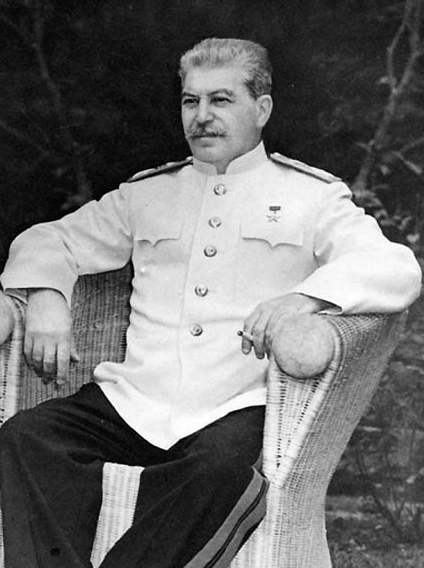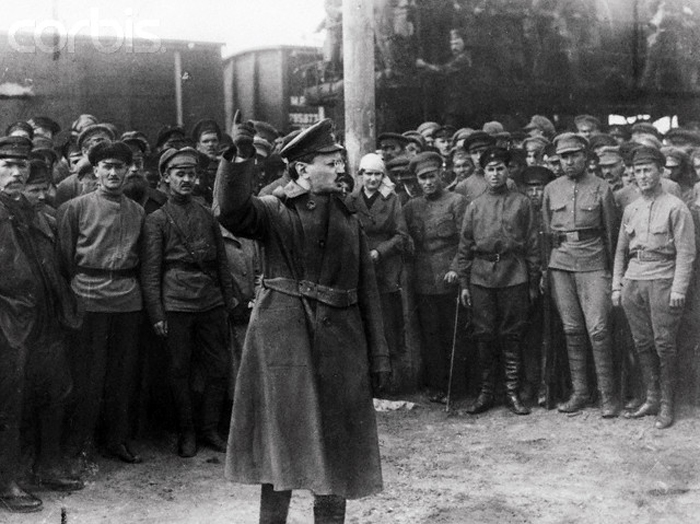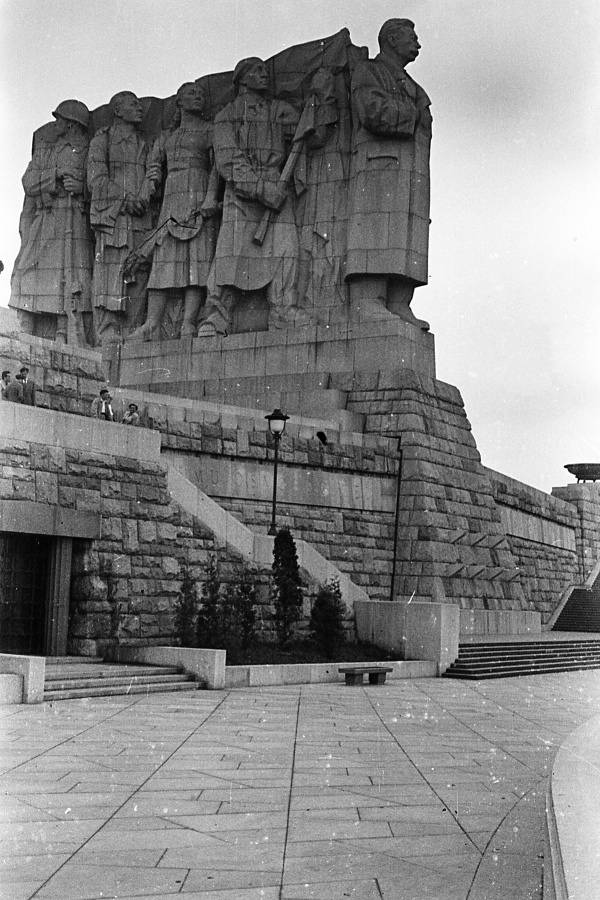|
Stalinist
Stalinism (, ) is the totalitarian means of governing and Marxist–Leninist policies implemented in the Soviet Union (USSR) from 1927 to 1953 by dictator Joseph Stalin and in Soviet satellite states between 1944 and 1953. Stalinism included the creation of a one man totalitarian police state, rapid industrialization, the theory of socialism in one country, forced collectivization of agriculture, intensification of class conflict, a cult of personality, and subordination of the interests of foreign communist parties to those of the Communist Party of the Soviet Union, which Stalinism deemed the leading vanguard party of communist revolution at the time. After Stalin's death and the Khrushchev Thaw, a period of de-Stalinization began in the 1950s and 1960s, which caused the influence of Stalin's ideology to begin to wane in the USSR. Stalin's regime forcibly purged society of what it saw as threats to itself and its brand of communism (so-called "enemies of the pe ... [...More Info...] [...Related Items...] OR: [Wikipedia] [Google] [Baidu] |
Marxism–Leninism
Marxism–Leninism () is a communist ideology that became the largest faction of the History of communism, communist movement in the world in the years following the October Revolution. It was the predominant ideology of most communist governments throughout the 20th century. It was developed by Joseph Stalin and drew on elements of Bolshevism, Leninism, and Marxism. It was the state ideology of the Soviet Union, Soviet satellite states in the Eastern Bloc, and various countries in the Non-Aligned Movement and Third World during the Cold War, as well as the Communist International after Bolshevization. Today, Marxism–Leninism is the De jure, de-jure ideology of the ruling parties of Chinese Communist Party, China, Communist Party of Cuba, Cuba, Lao People's Revolutionary Party, Laos, and Communist Party of Vietnam, Vietnam, as well as many other communist parties. The Juche, state ideology of North Korea is derived from Marxism–Leninism, although its evolution is disput ... [...More Info...] [...Related Items...] OR: [Wikipedia] [Google] [Baidu] |
Totalitarianism
Totalitarianism is a political system and a form of government that prohibits opposition from political parties, disregards and outlaws the political claims of individual and group opposition to the state, and completely controls the public sphere and the private sphere of society. In the field of political science, totalitarianism is the extreme form of authoritarianism, wherein all socio-political power is held by a dictator. This figure controls the national politics and peoples of the nation with continual propaganda campaigns that are broadcast by state-controlled and state-aligned private mass communications media. The totalitarian government uses ideology to control most aspects of human life, such as the political economy of the country, the system of education, the arts, sciences, and private morality of its citizens. In the exercise of socio-political power, the difference between a totalitarian regime of government and an authoritarian regime of government is ... [...More Info...] [...Related Items...] OR: [Wikipedia] [Google] [Baidu] |
History Of The Soviet Union (1927–1953)
The history of the Soviet Union between 1927 and 1953, commonly referred to as the Stalin Era or the Stalinist Era, covers the period in Soviet history from the establishment of Stalinism through victory in the Second World War and down to the death of Joseph Stalin in 1953. Stalin sought to destroy his enemies while transforming Soviet society with central planning, in particular through the forced collectivization of agriculture and rapid development of heavy industry. Stalin consolidated his power within the party and the state and fostered an extensive cult of personality. Soviet secret-police and the mass-mobilization of the Communist Party served as Stalin's major tools in molding Soviet society. Stalin's methods in achieving his goals, which included party purges, ethnic cleansings, political repression of the general population, and forced collectivization, led to millions of deaths: in Gulag labor camps and during famine. World War II, known as "the Great ... [...More Info...] [...Related Items...] OR: [Wikipedia] [Google] [Baidu] |
Stalin 1945
Joseph Vissarionovich Stalin (born Dzhugashvili; 5 March 1953) was a Soviet politician and revolutionary who led the Soviet Union from 1924 until Death and state funeral of Joseph Stalin, his death in 1953. He held power as General Secretary of the Communist Party of the Soviet Union, General Secretary of the Communist Party from 1922 to 1952 and as the fourth Premier of the Soviet Union, premier from 1941 until his death. He initially governed as part of a Collective leadership in the Soviet Union, collective leadership, but Joseph Stalin's rise to power, consolidated power to become an absolute dictator by the 1930s. Stalin codified the party's official interpretation of Marxism as Marxism–Leninism, while the totalitarian political system he created is known as Stalinism. Born into a poor Georgian family in Gori, Georgia, Gori, Russian Empire, Stalin attended the Tiflis Theological Seminary before joining the Marxist Russian Social Democratic Labour Party. He raised f ... [...More Info...] [...Related Items...] OR: [Wikipedia] [Google] [Baidu] |
Communist Party Of The Soviet Union
The Communist Party of the Soviet Union (CPSU),. Abbreviated in Russian as КПСС, ''KPSS''. at some points known as the Russian Communist Party (RCP), All-Union Communist Party and Bolshevik Party, and sometimes referred to as the Soviet Communist Party (SCP), was the founding and ruling political party of the Soviet Union. The CPSU was the One-party state, sole governing party of the Soviet Union until 1990 when the Congress of People's Deputies of the Soviet Union, Congress of People's Deputies modified Article 6 of the Soviet Constitution, Article 6 of the 1977 Soviet Constitution, which had previously granted the CPSU a monopoly over the political system. The party's main ideology was Marxism–Leninism. The party was outlawed under Russian President Boris Yeltsin's decree on 6 November 1991, citing the 1991 Soviet coup attempt as a reason. The party started in 1898 as part of the Russian Social Democratic Labour Party. In 1903, that party split into a Menshevik ("mino ... [...More Info...] [...Related Items...] OR: [Wikipedia] [Google] [Baidu] |
Gulag
The Gulag was a system of Labor camp, forced labor camps in the Soviet Union. The word ''Gulag'' originally referred only to the division of the Chronology of Soviet secret police agencies, Soviet secret police that was in charge of running the forced labor camps from the 1930s to the early 1950s during Joseph Stalin's rule, but in English literature the term is popularly used for the system of forced labor throughout the Soviet era. The abbreviation GULAG (ГУЛАГ) stands for "Гла́вное управле́ние исправи́тельно-трудовы́х лагере́й" (Main Directorate of Correctional Labour Camps), but the full official name of the agency #Etymology, changed several times. The Gulag is recognized as a major instrument of political repression in the Soviet Union. The camps housed both ordinary criminals and political prisoners, a large number of whom were convicted by simplified procedures, such as NKVD troikas or other instruments of extra ... [...More Info...] [...Related Items...] OR: [Wikipedia] [Google] [Baidu] |
Industrialization In The Soviet Union
Industrialization in the Soviet Union was a process of accelerated building-up of the industrial potential of the Soviet Union to reduce the economy's lag behind the developed capitalist states, which was carried out from May 1929 to June 1941. The official task of industrialization was the transformation of the Soviet Union from a predominantly agrarian state into a leading industrial one. The beginning of socialist industrialization as an integral part of the "triple task of a radical reorganization of society" (industrialization, economic centralization, collectivization of agriculture and a cultural revolution) was laid down by the first five-year plan for the development of the national economy lasting from 1928 until 1932. In Soviet times, industrialization was considered a great feat. The rapid growth of production capacity and the volume of production of heavy industry (4 times) was of great importance for ensuring economic independence from capitalist countries and s ... [...More Info...] [...Related Items...] OR: [Wikipedia] [Google] [Baidu] |
Khrushchev Thaw
The Khrushchev Thaw (, or simply ''ottepel'')William Taubman, Khrushchev: The Man and His Era, London: Free Press, 2004 is the period from the mid-1950s to the mid-1960s when Political repression in the Soviet Union, repression and Censorship in the Soviet Union, censorship in the Soviet Union were relaxed due to Nikita Khrushchev's policies of de-Stalinization and peaceful coexistence with other nations. The term was coined after Ilya Ehrenburg's 1954 novel ''The Thaw (Ehrenburg novel), The Thaw ''("Оттепель"), sensational for its time. The Thaw became possible after the Death and state funeral of Joseph Stalin, death of Joseph Stalin in 1953. General Secretary of the Communist Party of the Soviet Union, First Secretary Khrushchev denounced former General Secretary Stalin in the On the Cult of Personality and Its Consequences, "Secret Speech" at the 20th Congress of the Communist Party of the Soviet Union, 20th Congress of the Communist Party, then ousted the Stalinism, S ... [...More Info...] [...Related Items...] OR: [Wikipedia] [Google] [Baidu] |
Joseph Stalin's Cult Of Personality
Joseph Stalin's cult of personality became a prominent feature of Soviet popular culture. Historian Archie Brown sets the celebration of Stalin's 50th birthday on 21 December 1929 as the starting point for his cult of personality. For the rest of Stalin's rule, the Soviet propaganda presented Stalin as an all-powerful, all-knowing leader, with Stalin's name and image displayed all over the country. Stalin's image in propaganda and the mass media The building of the cult of personality around Stalin had to proceed judiciously, as British historian Ian Kershaw explains in his history of Europe in the first half of the 20th century, ''To Hell and Back'': A Stalin cult had to be built carefully. This was not just because the man himself was so physically unprepossessing – diminutive and squat, his face dominated by a big walrus mustache and heavily pitted from smallpox – or that he was a secretive, intensely private individual who spoke in a quiet, undemonstra ... [...More Info...] [...Related Items...] OR: [Wikipedia] [Google] [Baidu] |
Soviet Union
The Union of Soviet Socialist Republics. (USSR), commonly known as the Soviet Union, was a List of former transcontinental countries#Since 1700, transcontinental country that spanned much of Eurasia from 1922 until Dissolution of the Soviet Union, it dissolved in 1991. During its existence, it was the list of countries and dependencies by area, largest country by area, extending across Time in Russia, eleven time zones and sharing Geography of the Soviet Union#Borders and neighbors, borders with twelve countries, and the List of countries and dependencies by population, third-most populous country. An overall successor to the Russian Empire, it was nominally organized as a federal union of Republics of the Soviet Union, national republics, the largest and most populous of which was the Russian SFSR. In practice, Government of the Soviet Union, its government and Economy of the Soviet Union, economy were Soviet-type economic planning, highly centralized. As a one-party state go ... [...More Info...] [...Related Items...] OR: [Wikipedia] [Google] [Baidu] |
De-Stalinization
De-Stalinization () comprised a series of political reforms in the Soviet Union after Death and state funeral of Joseph Stalin, the death of long-time leader Joseph Stalin in 1953, and Khrushchev Thaw, the thaw brought about by ascension of Nikita Khrushchev to power, and his 1956 secret speech "On the Cult of Personality and Its Consequences", which denounced Stalin's cult of personality and the Stalinism, Stalinist political system. List of statues of Joseph Stalin, Monuments to Stalin were removed, his List of places named after Joseph Stalin, name was removed from places, buildings, and State Anthem of the Soviet Union, the state anthem, and his body was removed from the Lenin Mausoleum (known as the Lenin and Stalin Mausoleum from 1953 to 1961) and buried. These reforms were started by the collective leadership which succeeded him after his death on 5 March 1953, comprising Georgi Malenkov, Premier of the Soviet Union; Lavrentiy Beria, head of the Ministry of Internal Affa ... [...More Info...] [...Related Items...] OR: [Wikipedia] [Google] [Baidu] |









